1. Review on offences recorded by the police, customs and border guard
1.1. Summary
In 2014, a total of 417,900 offences were recorded by the police, customs and border guard in the whole country, which is 6,900 (1.6 per cent) lower than one year before. The number of offences reported has fallen from 2011, when 458,300 offences were reported. Over the year, 236,700 offences were solved, while the corresponding figure was 246,000 one year previously.
The vast majority of the offences was recorded by the police. A total of 13,700 offences were recorded by the customs and border guard, which was 3.3 per cent of all offences reported to the authorities. A total of 8,700 offences were recorded by the customs, which was 9.3 per cent lower than one year before. A total of 5,000 offences were recorded by the border guard, which was 12.5 per cent fewer than one year before. Around one-quarter of the offences recorded by the customs and border guard were alcohol offences or minor alcohol offences and narcotics offences.
Stalking was criminalised starting from 1 January 2014. In all, 600 reports of stalking were recorded during the year.
Examined by region, the number of offences increased in the regions of Central Finland (+6.0%), Central Ostrobothnia (+5.9%), Kymenlaakso (+4.9%), Satakunta (+4.4%), Kanta-H�me (+3.8%), Lapland (+2.5%), P�ij�t-H�me (+1.1%) and Pirkanmaa (+0.3%) The number of offences fell most in relative terms in the region of North Karelia, by 9.2 per cent from the year before.
Relative to the population, the highest numbers of offences were recorded in the regions of Uusimaa, South Karelia and Kymenlaakso. In the whole country, 7,666 offences per 100,000 population were recorded.
Figure 1. Offences by region per 100,000 population in 2014
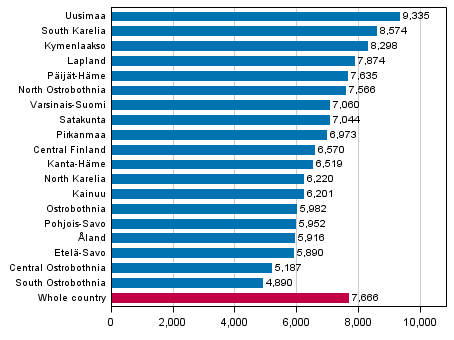
1.2. Offences against property
In 2014, 241,300 offences against property were recorded, which was 0.3 per cent more than the year before. Among offences against property, theft offences (thefts, petty thefts and aggravated thefts) formed the biggest group. In all, 143,100 of them were reported, which was 1.2 per cent more than one year previously. The number of theft offences has mainly been falling throughout the 2000s, but during the past two years, the number of theft offences recorded has grown slightly. The number of thefts recorded in 2014 was 70,800, or 0.6 per cent more than one year before. The recorded number of aggravated thefts was 3,700, which was 20.6 per cent more than in 2013. The number of petty thefts recorded was 68,600, which was 1.0 per cent more than in 2013. One-third (49,400) of theft offences were thefts and petty thefts from shops. Compared with 2013, the number of thefts from shops grew by 3.9 per cent.
The number of burglaries (thefts, aggravated thefts or petty thefts through unlawful breaking in) reported was 34,000, which was 4.5 per cent more than in 2013. The number of break-ins into free-time residences increased by 2.7 per cent. In 2014, 1,800 of them were reported. Breaking into residences went up most, by 14.3 per cent from the previous year. A total of 4,500 of them were recorded. Breaking into a motor vehicle decreased by 3.6 per cent.
Figure 2. Burglaries 2014
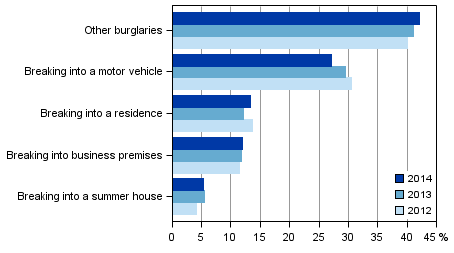
Nearly five per cent of offences against property were damages to property. In all, 42,500 of them were recorded, which was 2.0 per cent lower than in 2013. The number of damages to property has been on the decline for a few past years.
The number of frauds (fraud, petty fraud, aggravated fraud) recorded was 23,500, which was 3.0 per cent more than in 2013. Frauds make up around one-tenth of offences against property. In all, 7,800 means of payment frauds were recorded, which was 2.2 per cent more than in 2013. The number of both frauds and means of payment frauds has been growing over the past ten years. In 2014, 77.1 per cent of the cases of means of payment frauds were committed by the cardholder (targeting one's own account).
In 2014, 1,400 accounting and debtor offences were recorded, which is 12.2 per cent more than in the previous year. Forgery offences (forgery, petty forgery, aggravated forgery, possession of forgery materials) recorded was 3,300, which was 12.1 per cent down on 2013.
The number of robberies reported was 1,700, which was 10.8 per cent more than in 2013. Of the robbery offences, 1,300, or 76.1 per cent, took place in a public place. Of the robberies, 12.8 per cent were aggravated.
Figure 3. Offences against property 2014 (In total 241,326 offences)
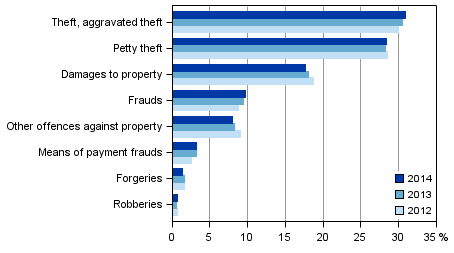
Table 1. Selected offences against property by region per 100,000 population in 2014
| Region | All offences against property | Burglaries | Unauthorised thefts of a motor vehicle | Robberies | Damages to property | Embezz- lements | Frauds, means of payment frauds |
| Whole country | 4,427 | 623 | 143 | 31 | 780 | 56 | 574 |
| Uusimaa | 5,764 | 649 | 149 | 50 | 1,097 | 80 | 594 |
| Varsinais-Suomi | 4,091 | 666 | 157 | 27 | 621 | 57 | 505 |
| Satakunta | 4,032 | 741 | 138 | 29 | 709 | 44 | 510 |
| Kanta-H�me | 3,443 | 532 | 93 | 20 | 679 | 51 | 431 |
| Pirkanmaa | 4,294 | 716 | 139 | 28 | 795 | 41 | 476 |
| P�ij�t-H�me | 4,479 | 791 | 200 | 20 | 741 | 57 | 522 |
| Kymenlaakso | 4,346 | 672 | 174 | 25 | 672 | 44 | 582 |
| South Karelia | 3,753 | 577 | 152 | 20 | 546 | 48 | 454 |
| Etel�-Savo | 3,223 | 673 | 147 | 9 | 540 | 31 | 408 |
| Pohjois-Savo | 3,059 | 487 | 85 | 21 | 609 | 47 | 422 |
| North Karelia | 2,834 | 322 | 95 | 8 | 625 | 27 | 362 |
| Central Finland | 3,635 | 643 | 94 | 26 | 623 | 51 | 479 |
| South Ostrobothnia | 2,348 | 416 | 58 | 11 | 405 | 33 | 385 |
| Ostrobothnia | 3,554 | 525 | 140 | 12 | 836 | 28 | 304 |
| Central Ostrobothnia | 2,567 | 288 | 45 | 16 | 511 | 44 | 285 |
| North Ostrobothnia | 4,362 | 621 | 205 | 37 | 588 | 50 | 660 |
| Kainuu | 2,728 | 363 | 85 | 16 | 623 | 43 | 423 |
| Lapland | 3,886 | 701 | 213 | 15 | 656 | 56 | 422 |
| �land | 2,644 | 433 | 80 | - | 600 | 73 | 255 |
1.3. Offences against the person
In 2014, a total of 32,900 assault offences (assault, petty assault, aggravated assault) were recorded, which was 2,600 cases (7.3 per cent) fewer than in 2013. Aggravated assaults decreased by 8.2 per cent compared to the previous year. The number recorded was 1,600. Over the past ten years, 34,000 assaults, on average, have been reported yearly. The law reform, which entered into force at the beginning of 2011, considerably increased the number of assault offences recorded in 2011. After the legislative amendment, petty assaults on minors or close relatives became officially prosecutable. In 2011, 40,200 assault offences were recorded.
The recorded number of offences against life was 101. This was six cases more than in 2013. The annual average for the past ten years was 110. The corresponding figure was 137 between 1995 and 2004. The number of attempted manslaughters, murders or killings grew by 63. A total of 327 of them were recorded. When recording an offence, the line between attempted manslaughter and aggravated assault is open to interpretation, which may have an effect on the level changes visible in the statistics.
In 2014, 64 per cent of offences against the person and 38 per cent of assault offences were committed in private dwellings.
A total of 1,009 rapes (rape, aggravated rape, coerced sexual intercourse, rape, paragraph 3) were recorded, when their number in 2013 was 975. From 2005 to 2014, an average of 840 rapes were reported per year. The recorded number of sexual exploitations of a child was 1,416, which was 14.5 per cent fewer than in the year before. The recorded numbers of rapes and sexual exploitations of a child vary much yearly. Individual reports may include a series of incidents comprising several criminal acts.
Table 2. Selected violent offences by region per 100,000 population in 2014
| Region | Manslaughter, murder, killing and their attempts | Assault | Aggravated assault | Petty assault | Rape offences |
| Whole country | 7 | 402 | 30 | 171 | 18 |
| Uusimaa | 6 | 483 | 27 | 178 | 21 |
| Varsinais-Suomi | 7 | 327 | 25 | 199 | 14 |
| Satakunta | 14 | 332 | 34 | 148 | 22 |
| Kanta-H�me | 13 | 330 | 37 | 197 | 17 |
| Pirkanmaa | 4 | 358 | 27 | 154 | 17 |
| P�ij�t-H�me | 8 | 318 | 32 | 152 | 19 |
| Kymenlaakso | 11 | 369 | 31 | 146 | 15 |
| South Karelia | 5 | 269 | 25 | 201 | 11 |
| Etel�-Savo | 7 | 343 | 14 | 228 | 13 |
| Pohjois-Savo | 6 | 381 | 30 | 236 | 18 |
| North Karelia | 10 | 321 | 30 | 195 | 11 |
| Central Finland | 8 | 477 | 41 | 148 | 20 |
| South Ostrobothnia | 4 | 347 | 31 | 100 | 20 |
| Ostrobothnia | 11 | 320 | 36 | 114 | 11 |
| Central Ostrobothnia | 2 | 484 | 32 | 131 | 8 |
| North Ostrobothnia | 9 | 386 | 30 | 122 | 14 |
| Kainuu | 5 | 562 | 33 | 252 | 12 |
| Lapland | 11 | 459 | 46 | 193 | 21 |
| �land | - | 401 | 10 | 160 | 62 |
1.4. Drunken driving and traffic offences
Aggravated drunken driving decreased by 7.7 per cent and other drunken driving increased by 3.5 per cent from 2013. In all, 17,600 drunken driving offences were recorded, which was 400 cases or 2.2 per cent lower than in the previous year. The number of drunken driving offences recorded has been decreasing in the past ten years. They have fallen by over one-third from the record figures of 1990.
In 73.9 per cent of drunken driving cases the intoxicant was alcohol and in 22.5 per cent some other narcotic substance. The remaining 3.7 per cent had used both. Drunken driving caused by alcohol decreased by 7.6 per cent and that caused by narcotic substances increased by 22 per cent.
Figure 4. Drunken driving offences in 1980–2014
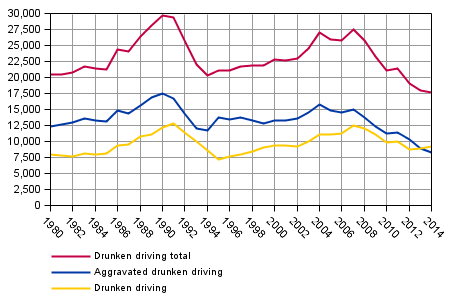
Figure 5. Drunken driving offences by region per 100,000 population in 2014
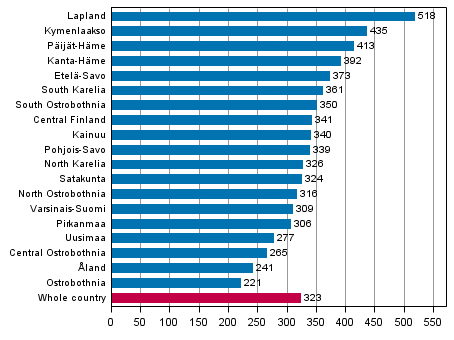
In 2014, 410,400 cases of endangerment of traffic safety and traffic infractions were registered, which was 7.7 per cent fewer than one year before. Most of them were offences found out in connection with police surveillance and guidance. The recorded number of aggravated endangerment of traffic safety was 3,900, which was 1.2 per cent more than in 2013. The police recorded 293,800 cases of exceeding speed limits, which was 7.0 per cent lower than in the year before. Problems connected to the re-organisation of automatic traffic control brought about a substantial fall in the number of traffic offences recorded in the early part of 2014 compared with 2013. The figures for 2013 are not fully comparable with those for 2012, because exceeding speed limits detected by automatic traffic control towards the end of 2012 were recorded in the early part of 2013.
1.5. Offences involving intoxicating substances
In all, 21,800 narcotics offences were recorded, which was 900 cases (3.9 per cent) fewer than in 2013. The number of aggravated narcotics offences went down by 6.1 per cent from the previous year. A total of 1,160 of them were recorded. The number of narcotics abuse offences grew most in absolute numbers, by 7.1 per cent. The recorded number was 13,700, which was 900 cases more than in 2013.
From 2009, the figures include the offences recorded by the customs and border guard, which increases the number of narcotics offences by about one-tenth compared with narcotics offences known to the police.
Figure 6. Narcotics offences in 2011–2014 (Total 21,781 offences)
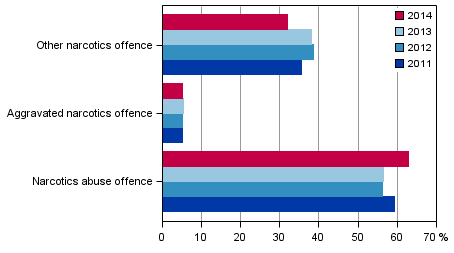
The recorded number of alcohol offences and minor alcohol offences was 3,700, which was 800 cases, or 17.6 per cent lower than in 2013.
When compiling statistics on offences involving intoxicating substances, offences comprising several criminal acts are entered as one. Offences involving intoxicating substances are such that they are generally found out only as a result of the activity of the police or customs and border guard officials and the majority of the offences remain undisclosed.
1.6. Solved offences
During 2014, the police, customs and border guard solved a total of 236,700 offences. The clearance rate was 56.6 per cent, which was 1.3 percentage points lower than in the previous year. The clearance rate for offences is calculated so that the offences recorded by the police in the statistical reference year and all the offences solved in that same year are compared with each other. For this reason, the clearance rate may be over 100 for some offences.
In all, 36.7 per cent of offences against property and 76.2 per cent of offences against life and health were solved.
Among municipalities of over 30,000 inhabitants the clearance rate was the highest in Kirkkonummi and Savonlinna, 66.5 and 65.2 per cent, respectively. The lowest clearance rates were found in Vaasa and Kerava, 45.8 and 48.5 per cent.
The clearance rate varies by type of offence quite strongly. Due to the manner of disclosure, drunken driving and traffic offences, and offences involving intoxicating substances almost all become solved. In all, 64.2 per cent of frauds and 79.2 per cent of offences against life were solved. The clearance rate was 75.9 per cent for assault offences.
The clearance rates are the lowest for theft offences (theft, aggravated theft, petty theft), damages to property, means of payment frauds and unauthorised thefts of a motor vehicle. In 2014, fewer than every sixth theft was solved. In turn, over one-half of petty thefts were solved. One-fifth of damages to property and less than one-sixth of means of payment frauds were cleared. One-third of unauthorised thefts of a motor vehicle were solved. Good one-half of robberies were solved.
Table 3. Clearance rate of certain types of offences in 1986-2014
| Offence | 1986 - 1990 | 1991 - 1995 | 1996 - 2000 | 2001 - 2005 | 2006 - 2010 | 2011 | 2012 | 2013 | 2014 |
| All offences 1) | 65 | 51 | 51 | 56 | 61 | 59 | 60 | 58 | 57 |
| Theft | 25 | 17 | 14 | 16 | 18 | 17 | 16 | 15 | 15 |
| Aggravated theft | 39 | 29 | 40 | 41 | 38 | 34 | 38 | 38 | 28 |
| Petty theft | 78 | 70 | 67 | 58 | 57 | 57 | 56 | 56 | 55 |
| Robbery | 53 | 43 | 42 | 45 | 49 | 49 | 55 | 53 | 52 |
| Damages to property | 29 | 27 | 27 | 26 | 25 | 21 | 23 | 22 | 21 |
| Attempted manslaughter, murder or killing | 96 | 91 | 92 | 94 | 97 | 91 | 97 | 92 | 92 |
| Assault | 79 | 74 | 76 | 80 | 81 | 75 | 78 | 77 | 78 |
| Aggravated assault | 85 | 84 | 83 | 87 | 88 | 85 | 84 | 87 | 82 |
| Petty assault | 95 | 86 | 79 | 75 | 73 | 73 | 75 | 75 | 70 |
| Rape | 63 | 56 | 57 | 63 | 66 | 59 | 72 | 79 | 70 |
| Sexual exploitation of a child | 91 | 84 | 88 | 82 | 86 | 62 | 91 | 63 | 80 |
1.7. Persons suspected of offences
In all, 236,300 persons were suspected of the 236,700 offences solved in 2014. The same person can be a suspect of several different offences. In all, 18.2 per cent of such suspects were women. When calculating according to the most aggravated offence of a person (a person can be a suspect only one time during the year), 97,300 different persons were suspects. Thus, one person was a suspect of 2.4 offences, on average.
The majority of suspects, 63.3 per cent, were suspects of only one offence in 2014. In all, 16.6 per cent were suspects of two offences. Of the suspects, 20.1 per cent were suspected of more than three offences.
Figure 7. Persons suspected by number of offences in 2014
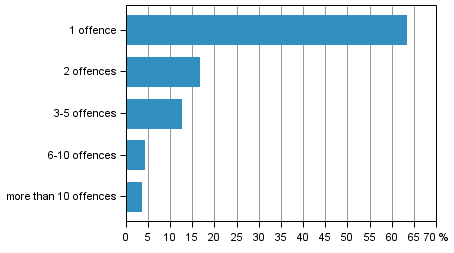
In addition to the quantitative difference, the criminality of men and women differs in that women's shares of assaults, drunken driving and damages to property were small compared to men. However, the share of women suspected of assaults and drunken driving has grown in 20 years. Typical crimes for women were petty thefts, frauds, embezzlements and forgeries. Women suspects are also slightly younger than men. The most common age for a woman suspect is 19 and that for a man suspect is 20 years.
Table 4. Suspects of solved offences by age and sex in 2005-2014, share per 1,000 population
| Gender/age group | 2005 | 2006 | 2007 | 2008 | 2009 | 2010 | 2011 | 2012 | 2013 | 2014 | |
| Total | Total | 57 | 54 | 58 | 58 | 56 | 56 | 56 | 52 | 51 | 48 |
| Aged under 15 | 11 | 11 | 12 | 15 | 14 | 13 | 14 | 11 | 10 | 9 | |
| Aged 15-17 | 137 | 118 | 118 | 124 | 118 | 120 | 128 | 111 | 105 | 94 | |
| Aged 18-20 | 199 | 183 | 183 | 183 | 166 | 163 | 169 | 158 | 156 | 144 | |
| Aged over 20 | 56 | 54 | 59 | 58 | 57 | 57 | 56 | 53 | 52 | 50 | |
| Male | Total | 97 | 93 | 96 | 99 | 94 | 94 | 94 | 87 | 84 | 80 |
| Aged under 15 | 16 | 15 | 18 | 23 | 19 | 18 | 20 | 15 | 14 | 13 | |
| Aged 15-17 | 224 | 190 | 192 | 202 | 187 | 185 | 197 | 173 | 162 | 148 | |
| Aged 18-20 | 331 | 297 | 302 | 300 | 267 | 264 | 273 | 257 | 253 | 230 | |
| Aged over 20 | 99 | 96 | 99 | 101 | 98 | 99 | 96 | 91 | 88 | 85 | |
| Female | Total | 17 | 17 | 21 | 19 | 19 | 19 | 20 | 18 | 18 | 17 |
| Aged under 15 | 7 | 6 | 6 | 7 | 7 | 8 | 8 | 6 | 6 | 4 | |
| Aged 15-17 | 47 | 42 | 41 | 43 | 47 | 52 | 55 | 47 | 45 | 39 | |
| Aged 18-20 | 60 | 62 | 58 | 62 | 60 | 58 | 60 | 55 | 55 | 54 | |
| Aged over 20 | 16 | 16 | 22 | 18 | 18 | 18 | 18 | 18 | 18 | 17 | |
In 2014 the share of young and underage people - aged 21 or under - among all suspects was 20.4 per cent. The shares of young people were large for alcohol offences, robberies, damages to property and thefts of a motor vehicle. Of suspects of robberies, 41.0 per cent were young people and 40.9 per cent of suspects of damages to property. In all, 19.6 per cent of those suspected of assaults were young people.
1.8. Backgrounds of suspects
The average income subject to state taxation (income tax is paid to the state on both earned income and capital income) of suspects aged 15 or over belonging to the registered population (living permanently and temporarily in Finland and with a Finnish personal identity code) was around EUR 17,800, while the corresponding income in total population was about EUR 27,800. The respective median income was approximately EUR 10,400 and EUR 23,000. Of the suspects, 30.6 per cent had an income of under EUR 5,000, while this was so for 10.4 per cent of the entire population. Among the suspects, 32.2 per cent had an income of at least EUR 20,000, while the share for the entire population was 56.3 per cent. All those whose income subject to state taxation is not known also belong to the group of under EUR 2,499. The figures given in Section 1.8. are calculated so that one person is a suspect only one time. The figures calculated here differ from the figures presented elsewhere in this publication where the same person can be a suspect several times during a year. Those guilty of endangerment of traffic safety or traffic infraction were not taken into account in the figures. The data on income subject to state tax of suspects are based on the National Board of Taxes' data in the tax database concerning income subject to state taxation from 2013. In the sections concerning total population, only people permanently resident in Finland were taken into consideration.
Table 5. Persons suspected of offences by sex and income (EURO) in 2014, aged 15 and over
| Income/sex | Total | - 2,499 | 2,500 - 4,999 | 5,000 -9,999 | 10,000 -19,999 | 20,000 -39,999 | 40,000 -79,999 | 80,000 and over | ||
| Income subject to state taxation | Sex total | Persons suspected | 94,664 | 24,021 | 5,044 | 16,951 | 18,077 | 20,650 | 8,340 | 1,581 |
| % | 100.0 | 25.3 | 5.3 | 17.9 | 19.0 | 21.8 | 8.8 | 1.6 | ||
| Men | Persons suspected | 74,644 | 19,143 | 3,996 | 12,867 | 13,473 | 16,457 | 7,282 | 1,426 | |
| % | 100.0 | 25.6 | 5.3 | 17.2 | 18.0 | 22.0 | 9.7 | 1.9 | ||
| Women | Persons suspected | 20,020 | 4,878 | 1,048 | 4,084 | 4,604 | 4,193 | 1,058 | 155 | |
| % | 100.0 | 24.3 | 5.2 | 20.3 | 22.9 | 20.9 | 5.2 | 0.7 | ||
| Disposable income | Sex total | Persons suspected | 94,664 | 15,256 | 4,450 | 12,957 | 34,007 | 23,828 | 3,411 | 755 |
| % | 100.0 | 16.1 | 4.7 | 13.6 | 35.9 | 25.1 | 3.6 | 0.7 | ||
| Men | Persons suspected | 74,644 | 12,280 | 3,700 | 10,641 | 25,888 | 18,454 | 2,984 | 697 | |
| % | 100.0 | 16.4 | 4.9 | 14.2 | 34.6 | 24.7 | 3.9 | 0.9 | ||
| Women | Persons suspected | 20,020 | 2,976 | 750 | 2,316 | 8,119 | 5,374 | 427 | 58 | |
| % | 100.0 | 14.8 | 3.7 | 11.5 | 40.5 | 26.8 | 2.1 | 0.2 | ||
When viewed by disposable money income, the income level of those suspected of offences was higher. The median of the suspects' disposable income is 69 per cent of that of total population. With income subject to state taxation, the share is 45 per cent. Of the suspects, 20.8 per cent had an income of under EUR 5,000, while according to income subject to state taxation, this group included 30.6 per cent of the suspects. The respective figures for the whole population are 8.8 and 10.4 per cent. Disposable income of over EUR 20,000 was earned by 29.4 per cent of suspects and 49.0 per cent of total population. Disposable income = earned income + entrepreneurial income + property income + current transfers received - current transfers paid. Disposable income is a better measure than income subject to state taxation for describing disposable income of suspects.
Figure 8. Persons suspected of offences and the entire population by income subject to state taxation and disposable income in 2014, aged 15 years and over
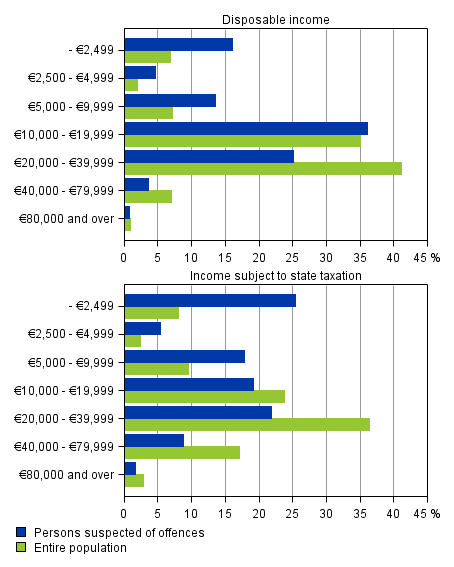
Classified by main type of activity, 37.4 per cent of the suspects (belonging to the registered population aged 15 or over) were employed persons. Of all suspects, 18.0 per cent were unemployed and 14.6 per cent in the inactive population. Of the whole population, 51.6 per cent were employed, 6.2 per cent unemployed and 4.2 per cent in the inactive population. The information on main type of activity is from 2012.
Figure 9. Persons suspected of offences and the entire population by main activity in 2014, aged 15 and over
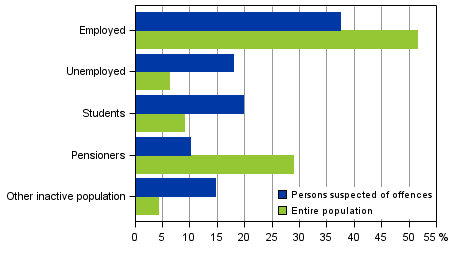
Of suspects aged 15 or over, 50.6 per cent had completed only basic level education and 38.8 per cent had completed secondary level education. The respective figures for the whole population were 30.4 and 40.3 per cent.
In Appendix tables 4 to 7, the same person can be a suspect several times. This is a common way to present the number of suspects of offences in the statistics. This produces a better view of criminality as a phenomenon and the backgrounds of the persons guilty of a particular offence can be described better.
1.9. Origin and foreign citizens
The number of persons suspected of the offences solved in 2014 by the police, customs and border guard was 263,300, of whom 33,000 were citizens of foreign countries. Compared to 2013, the number of all suspects decreased by 4.7 per cent, while the number of foreign citizens suspected went down by 5.1 per cent. The share of foreign nationals in all suspects was 12.5 per cent. In 2014, Estonians (7,900) and Russians (7,400) made up the biggest group of foreign suspects. Of Estonian suspects, 41.3 per cent and 26.1 per cent of Russians had a permanent place of residence in Finland. Compared with the year before, the number of offences by Estonians decreased by 2.5 per cent and those by Russians by 9.2 per cent.
Other countries where over 1,000 of its citizens were suspected were Romania (1,800), Somalia (1,400), Iraq (1,400) and Sweden (1,300). Of Romanians, only 6.2 per cent had a permanent place of residence in Finland. The respective percentages for Somalis and Iraqis were 95.2 and 84.0. Of Swedes, 55.6 per cent had a permanent place of residence in Finland. One person can be guilty of many different offences during a year.
Figure 10. Foreign citizens suspected of offences by place of residence in Finland in 2009–2014
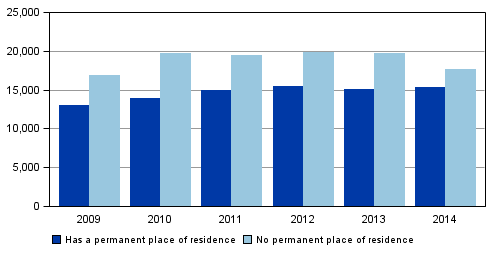
Among the offences solved in 2014, 46.4 per cent of the suspected foreign citizens were living permanently in Finland. The share was three percentage points higher than in 2013. Foreign suspects living in Finland were slightly younger than Finnish suspects were. Their average age was 31 years, while that of Finnish suspects was 32 years. Typical offences by foreigners living in Finland were theft, assault and narcotics offences, as well as driving a motor vehicle without a licence.
In the statistics, the same person can be a suspect several times. Data on the nationality of suspects and on whether they are permanently resident in Finland or not are based on the nationality data derived from the police and those selected by means of the personal identity code from the population data. The group "no permanent place of residence in Finland" is in that sense problematic, because it may include persons staying longer periods in Finland without applying for a permanent place of residence here. The group may also include persons suspected of a narcotics offence, for example, who have come to Finland only for the purpose of committing a crime.
Table 6. Suspects of solved offences living in Finland by age and nationality in 2014
| Age group | Suspects living permanently in Finland | Share per 1,000 population in the age group | ||
| Finnish residents | Foreign citizens | Finnish residents | Foreign citizens | |
| -14 | 7,220 | 456 | 8.4 | 14.8 |
| 15-17 | 16,039 | 769 | 90.8 | 151.7 |
| 18-20 | 26,462 | 1,170 | 137.3 | 196.9 |
| 21-24 | 30,562 | 1,839 | 117.1 | 140.2 |
| 25-29 | 33,499 | 3,281 | 107.5 | 116.1 |
| 30-34 | 29,566 | 2,622 | 92.2 | 87.1 |
| 35-39 | 23,023 | 1,781 | 72.9 | 73.0 |
| 40-49 | 32,032 | 2,335 | 49.3 | 67.9 |
| 50-59 | 19,280 | 838 | 26.5 | 41.1 |
| 60-69 | 8,344 | 208 | 11.5 | 23.2 |
| 70- | 2,295 | 45 | 3.3 | 7.5 |
| Total | 228,322 | 15,344 | 43.5 | 73.9 |
Of the 99,500 persons suspected of offences, 87,100 (87.5 per cent) were of Finnish background. There were 10,300 suspects with foreign background (10.3 per cent). The figures were calculated so that a person is a suspect only one time during the year, which means that this is not the "gross number" of suspects. In the whole population, 94.5 per cent are of Finnish background and 5.5 per cent of foreign background. Of suspects with Finnish background, 1,800 (2.1 per cent) had been born abroad. Of suspects with foreign background, 92.5 per cent had been born abroad. Of all suspects, 2,100 (2.2 per cent) were such that their origin was not known although they had a Finnish personal identity code. Typically such persons have moved away from Finland.
Suspects born in Finland with Finnish background numbered 16.7 per 1,000 population with the same origin. In turn, the figure for foreign-born suspects with Finnish background was 38.3. Good one-half of foreign-born persons with Finnish background were born in Sweden. The share of Finnish-born suspects with foreign background per 1,000 population was 17.0 and that of foreign-born persons with foreign background was 37.1.
Table 7. Persons suspect of offences by origin and share per 1,000 population 2014
| Origin | Suspected | Share per 1,000 population |
| Origin total | 99,473 | 18.2 |
| Person with Finnish background total | 87,065 | 16.9 |
| Person with Finnish background born in Finland | 85,225 | 16.7 |
| Person with Finnish background born abroad | 1,840 | 38.3 |
| Person with foreign background total | 10,269 | 34.1 |
| Person with foreign background born in Finland | 769 | 17.0 |
| Person with foreign background born abroad | 9,500 | 37.1 |
| Origin unknown | 2,139 | - |
In the review, included are persons belonging to the registered population, that is, people with a Finnish personal identity code. A person whose one or both parents were born in Finland is counted as having Finnish background. A person has foreign background if his or her both parents were born abroad. There are more of younger age groups and men among persons with foreign background compared with those with Finnish background. In all, 64.6 per cent of those with foreign background and 46.3 per cent of those with Finnish background are aged under 40.
More details about the origin of suspects by age group and sex is available in the appendix table. The figures are calculated so that one person is a suspect only one time. The figures calculated here differ from the figures presented elsewhere in this publication where the same person can be a suspect several times during a year.
If the number of suspects is calculated so that the same person can be a suspect of several crimes, the number of suspects with Finnish background was 223,000 (84.7 per cent of suspects). Of them, 215,500 were born in Finland and 7,500 abroad. Suspects with foreign background numbered 20,900 (7.9 per cent of suspects). Of persons with foreign background, 1,800 were born in Finland and 19,100 abroad. Among suspects, 4,500 (1.7 per cent) were of unknown origin and 15,000 (5.7 per cent) did not have population information. Population information is missing for tourists and those staying temporarily in the country, for example.
Source: Statistics on offences and coercive measures 2014, Offences reported. Statistics Finland
Inquiries: Kimmo Haapakangas 029 551 3252, rikos@stat.fi
Director in charge: Riitta Harala
Updated 31.3.2015
Official Statistics of Finland (OSF):
Statistics on offences and coercive measures [e-publication].
ISSN=2342-9178. Reported offences, 1st quarter 2014,
1. Review on offences recorded by the police, customs and border guard
. Helsinki: Statistics Finland [referred: 19.4.2025].
Access method: http://stat.fi/til/rpk/2014/13/rpk_2014_13_2015-03-31_kat_001_en.html

